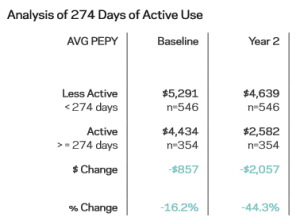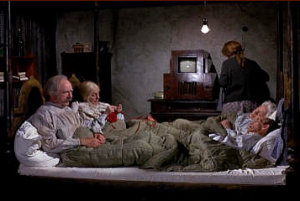Oh, so lovely sittin’
Abso-bloomin’-lutely still
I would never budge till spring
Crept over me window sill
–Eliza Doolittle
Springbuk has found the key to dramatic reduction in healthcare spending: getting out of bed. It doesn’t matter whether it’s to eat, find the remote, or, of course, pee. Just do something, anything, other than lie in bed all day — and you count as an “active” person who saves a ton of money, as compared to people who never get out of bed. Yes, Springbuk classifies you as “active” if you take at least 100 steps a day:
My question, for now, is not about how all this money was allegedly saved. Rather, my question for now is: how did these “less active” people — a huge chunk of the total population studied –manage to take fewer than 100 steps a day in the first place? Consider this random floor plan:
Now overlay the steps you take just in order to get up in the morning. A one-way trip to the bathroom and then to the breakfast nook appears to require about 20 steps. You haven’t even had your coffee yet and already you are a fifth of the way to your daily goal.
Speaking of coffee, add in a few more trips to the bathroom and <voila> you’ve reached your steps goal. Conclusion: it is impossible not to walk 100 steps a day, unless you want to starve to death, burst your bladder, or work at Spacely’s Sprockets. We wouldn’t recommend any of those three, especially the last, a very high-stress environment.
As a sidebar, I would note that George Jetson ironically has a lower BMI than Fred Flintstone, thus showing that taking more than 100 steps a day doesn’t reduce weight. Nor does a paleo diet, apparently. (Portion sizes might have something to do with it.) On the other hand, Fred can power his own car, thus showing the value of maintaining health at any size.
The Economics of Getting out of Bed
And needless to say, Springbuk provides some very compelling economics about the cost savings impact of getting out of bed. 100 steps a day for only 274 days a year (meaning you can take a well-deserved breather on weekends, holidays, vacation days and Beethoven’s birthday) generates a dramatic 28% reduction in costs. Wow! Who knew that peeing, eating, and looking for the remote (try your fridge or dresser drawers) could be so beneficial to your health?
Springbuk has additional bad news and good news.
The bad news is that taking 100 steps a day for more than 182 days (as opposed to more than 274 days) makes only a 3% differential impact on health spending, vs. taking 100 steps a day for less than 182 days. Still, there is some good news, which is that staying in bed for half the year also generates a huge reduction in costs, 31% to be exact.
Springbuk didn’t mention this, but the only way both these findings could be consistent would be that people –we will call them “semi-active” — who take 100 steps on more than 182 days but fewer than 274 days must have ridiculously high, off-the-charts healthcare spending and presumably morbidity. Apparently, moving those semi-active people between “less active” and “active” swings overall healthcare spending for the entire population by 25%.
The implication, as any exercise physiologist would tell you, is that starting in January, you need to track the number of days on which you take 100 steps. If you get to 181 such days by late summer, but don’t think you can make it to 274 days by the end of the year, then your best bet, statistically speaking, is to stay in bed until the ball drops in Times Square. Your bosses will love you for it, because you’ll be saving them 31%.
Naturally, Springbuk’s findings contradict all the other findings on wearables showing trivial changes in activity due to wearables after a short burst of interest. These trivial changes predictable show only trivial improvements in health and costs.
And someone should tell the Einsteins at Springbuk what anyone with a triple-digit IQ could intuit and what every other study shows: that a typical American takes many times more than 100 steps a day. 6886 steps per day, according to one study. So Springbuk’s study is wrong, making them eligible for a Koop Award.
Springbuk’s analysis may be wrong for another reason too: It does not account for the health hazards of taking too many steps. (Yes, you need to click through for the punchline.)
An accurate line in this report
I can’t believe I missed this, but Pete Aren didn’t, and pointed it out on linkedin. There is indeed one accurate line in their report, buried in the footnotes:
“Springbuk does not certify the information, nor does it guarantee the accuracy and completeness of such information.”














Hilarious and loved the punchline.
LikeLike
Love the pop culture references, as usual! Apparently the creators of The Jetsons were also unaware of the dreaded “sitting disease”.
LikeLike
I just stumbled upon this on Linkedin as I am no longer in the industry but always found your posts enlightening. But, did you ever think that the 100 steps was just a typo?
LikeLike
The industry needs more people like you — please come back. To your specific question, “100 steps” appears about 20 times in their report.
LikeLike
Understood. I didn’t read the report. but thanks for clarifying!
LikeLike
Jessica I had exactly the same thought! I was curious and did download and read the report. I have no axe to grind here and don’t know the company, however it appears to me on a casual read of the report that 100 steps was referenced not as a recommendation but as an indicator of device ‘use’ versus non use on any given day. Among ‘users’ who wore the device at least 365 days in a two year period the report then goes on to discuss the number of steps and segments into low and high step counts – low averaging 6,673 steps and high averaging 10,813. Could the analyses and report writing have been improved? Absolutely! Mr Lewis is practicing the art of misrepresentation and alternative ‘facts’ to fuel his own agenda.
LikeLike
Our policy is to publish all comments, even anonymous ones. If in fact your interpretation is correct, according to Figure 2c all you have to do is put the device on — it doesn’t matter how many steps you take — and your healthcare costs fall by 31%+. And yet all the literature shows no impact on corporate healthcare spending from wearables.
If you would like to challenge my “alternative facts” I invite you to claim the $2-million reward, rather than just insult me. http://insurancethoughtleadership.com/2-million-reward-if-wellness-works/
LikeLike
[…] is a sequel to “Springbuk Wants Employees to Go to the Bathroom,” which should be read prior to reading this […]
LikeLike
I worship you.
LikeLike
(blushing) thank you
LikeLike